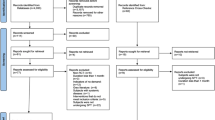Abstract
Data sources Medline provided the primary data source and references lists from the identified papers were reviewed to source additional studies.
Study selection Studies published in English prior to December 2001 were included if they were primary randomised controlled trials; were conducted in human subjects; examined the effects of local tetracycline in various forms in reducing probing depth (PD) and/or improving attachment level (AL); and they reported mean and measures of variance of PD and AL.
Data extraction and synthesis The methods and results section of each article were read and scored by two independent readers. Meta-analyses were performed on the basis of baseline PD, type of antibiotic used, and experimental and control regimens. A random-effects model was used to combine data.
Results A total of 29 studies met the inclusion criteria and were included in the meta-analyses. The quality assessment showed the studies to be of variable quality, with many failing to report relevant information. A significant mean reduction in PD was observed when tetracycline was used as an adjunct to scaling and root planing (SRP; mean difference at 12 weeks, 0.69 mm; 95% confidence interval, 0.57–0.81; P<0.001). Tetracycline alone did not result in a statistically significant clinical improvement compared with SRP but did perform better than placebo for people whose PD was >6 mm after 4 (P<0.001) and 8 (P=0.005) weeks.
Conclusions The meta-analyses demonstrated that statistically significant, although not clinically substantial, improvement could be achieved in cases of chronic periodontitis when local delivery of tetracycline was used as an adjunct to scaling and root planing.
Similar content being viewed by others
Commentary
This paper presents a meta-analysis of the local delivery of tetracycline in the treatment of chronic periodontitis. In an age where there is increasing demand for evidence-based therapeutic intervention, meta-analysis is a useful and appropriate tool, and the topic presented in this paper is relevant to all dentists.
Because plaque bacteria are the initiators of periodontal disease there has long been interest in using antimicrobial and antiseptic agents to inhibit them. The problems with use of systemic antibiotics are well-recognised and thus local delivery systems — with their advantages of being site-specific, able to produce high local concentration of agents with very low systemic spill-over, their virtually negating the problems of patient compliance and having a lower risk of causing super-infection — have been regarded as attractive alternative.
Dental plaque is a complex, dynamic biofilm of bacteria and matrix: the mutual protection provided by this structure means that bacteria within it are very resistant to chemical agents. The biofilm thus must be physically disrupted before antimicrobial agents are employed. It is not surprising therefore that this paper reports that the use of tetracycline alone, which would not disrupt the biofilm, did not give a better outcome (reduced PD or gain in AL) than standard mechanical therapy alone.
The statistical analysis of the data in this review is appropriate but, as always, there is the fundamental problem that statistically significant results are not necessarily clinically relevant. In this case, the differences in PD and AL reported as statistically significant are so small as to be clinically meaningless.
Whenever a drug is administered to a patient, problems can follow, including patient sensitivity and drug interactions. Weighing up the potential advantages and disadvantages of the local delivery systems studied, the authors conclusion that, “local delivery systems of tetracycline should be considered cautiously and this antibiotic should rather be used as a complement to conventional therapy or when it has not proven successful” is pragmatic and useful. Add to this the fact that local delivery agents are generally quite expensive and that re-infection of pockets from bacterial reservoirs in the mouth is likely, local delivery agents should be reserved for use in specific situations and not as a general panacea.
Practice point
-
Local delivery agents should be used as an adjunct and not an alternative to mechanical therapy in the treatment of periodontal diseases.
Author information
Authors and Affiliations
Additional information
Address for correspondence: IF Angelillo, Medical School, University of Catanazarro “Magna Graecia”, Via Tommaso Campanella, 88100 Cantanzarro, Italy. E-mail: angelillo@unicz.it
Pavia M, Nobile CG, Angelillo IF. Meta-analysis of local tetracycline in treating chronic periodontitis. J Periodontol 2003; 7:916–932
Rights and permissions
About this article
Cite this article
Gilbert, A. Local tetracycline is an effective adjunct in the treatment of chronic periodontitis. Evid Based Dent 5, 67 (2004). https://doi.org/10.1038/sj.ebd.6400275
Published:
Issue Date:
DOI: https://doi.org/10.1038/sj.ebd.6400275



